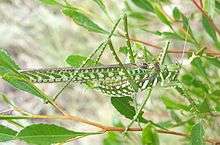Chlorobalius leucoviridis
Chlorobalius leucoviridis, commonly known as the spotted predatory katydid,[1] is a species of long-horned grasshopper in the family Tettigoniidae. It is a predator and is an acoustic aggressive mimic of cicadas; by imitating the sounds and movements made by female cicadas, it lures male cicadas to within its reach and then eats them.
| Chlorobalius leucoviridis | |
|---|---|
 | |
| Scientific classification | |
| Kingdom: | |
| Phylum: | |
| Class: | |
| Order: | |
| Family: | |
| Genus: | Chlorobalius |
| Species: | C. leucoviridis |
| Binomial name | |
| Chlorobalius leucoviridis Tepper, 1896 | |
| Synonyms | |
| |
Taxonomy
Chlorobalius leucoviridis was first described by the Prussian/Australian botanist and entomologist Johann Gottlieb Otto Tepper in 1896. It forms part of the family Tettigoniidae, the subfamily Listroscelidinae and the tribe Terpendrini, the gum-leaf katyatids. It is the only species in the monotypic genus Chlorobalius.[2]
Description
The adult Chlorobalius leucoviridis is a large, cryptically-coloured, long-horned grasshopper. The body, wings and legs are barred and spotted in green and white. The legs bear short spines and both males and females have stridulatory organs,[1] the male has a file-and-scraper structure on the tegmen (fore-wing) while the female has pegs on the hind wing which rub against certain veins on the fore-wing.[3]
Distribution and habitat

Chlorobalius leucoviridis is native to arid, inland regions of Australia. It is typically found high in a large bush or small tree.[1]
Behaviour
Chlorobalius leucoviridis is nocturnal and occurs in small groups which move from one location to another.[2] It feeds by catching other insects such as flies, grasshoppers and other katydids, grasping the prey with its fore-legs or first two pairs of legs, and immobilising it by biting it under the throat. The spines on the legs seem to play a part in controlling larger prey items.[1] The male makes loud, trilling songs to lead females of its own species towards its location.[1]
The male attracts male cicadas on which to feed by mimicry, luring them to its vicinity by deception. This is accomplished both acoustically, by audible wing-clicking in a pattern similar to that used by sexually-receptive female cicadas, and visually by the use of synchronised body movements similar to those exhibited by the females.[4] Remarkably, the katydid has the ability to mimic the sounds and movements of a number of different prey species, even some species with which it has never had direct contact.[4]
References
- Shapiro, Leo. "Chlorobalius leucoviridis: Spotted predatory katydid". EoL. Retrieved 8 November 2018.
- Rentz, David C. (2010). A Guide to the Katydids of Australia. Csiro Publishing. pp. 55–56. ISBN 978-0-643-09554-0.
- Rentz, David C. (2010). A Guide to the Katydids of Australia. Csiro Publishing. p. 26. ISBN 978-0-643-09554-0.
- Marshall, D.C.; Hill, K.B.R. (2009). Chippindale, Adam K. (ed.). "Versatile aggressive mimicry of cicadas by an Australian predatory katydid". PLOS ONE. 4 (1): e4185. Bibcode:2009PLoSO...4.4185M. doi:10.1371/journal.pone.0004185. PMC 2615208. PMID 19142230.